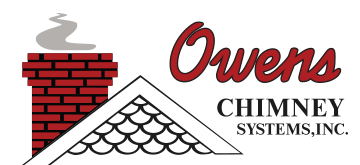Higher than any other part of your house, your chimney is the part left out there to survive harsh winters and heavy rains. Yet, it is often neglected, and over time, mortar deteriorates, water seeps in, and the structure begins to weaken. Even metal flues can be compromised by moisture, and rust is, of course, a common problem.

Protruding above the roof line, the chimney is exposed to rain and snow and needs to be protected from water damage. Once water penetrates the brick and mortar, it freezes and thaws, contracting and expanding. This ultimately causes a weakness in the masonry, placing a stress on its structural integrity.
A cracked flue liner can lead to all sorts of problems, including a chimney fire or even fire in the frame of the house itself. The purpose of the flue liner is to keep excessive heat away from those flammable wood materials. It also protects the chimney from the damage done by the gases that move through it and out of the house. Over time, the acid in those gases corrodes the mortar joints in the chimney and heat transfers more quickly to surrounding materials. Flue liners also make the chimney more efficient, providing the proper size and fit to maximize its draft.
Obviously, then, protecting the chimney from water damage should be foremost among your considerations regarding chimney upkeep. A number of waterproofing agents are available which allow the chimney to breathe out but not in. This means that any moisture which may already have accumulated in the chimney can escape but no new water is admitted.
While chimney chase covers and caps perform important functions and should be part of your waterproofing efforts, waterproofing itself is essential. A vapor-permeable sealant should be applied by a professional trained to determine which of the available products is best for your chimney. This investment now will prevent costly repairs and even reconstruction of a chimney that, over time, will fail simply from moisture.
